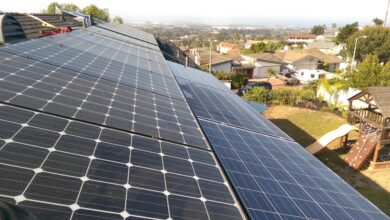This Sleek Electric Boat Flies Like An Airplane, With Fuel Cells

Sign up for daily news updates from CleanTechnica on email. Or follow us on Google News!
Activity is picking up in the field of wing-in-ground effect vessels, which are classified as boats despite appearing to fly like airplanes. The classification is important because an electric boat with wing-in-ground effect can berth at seaports and other coastal landings that a regular aircraft cannot access, but it is much speedier than an ordinary boat.
An Electric Boat That Flies Like An Airplane
The wing-in-ground effect is not the same as the more familiar hydrofoil, where activity has been stirring in the areas of eco-sensitive passenger transportation, boat racing, and recreation. However, the two technologies follow the same general idea of levitating a vessel above the surface of water to improve fuel efficiency and increase speed, while improving passenger comfort. For an electric boat, those advantages are combined with the benefits of a relatively quiet, zero emission ride.
Wing-in-ground effect refers to a pocket of air that forms under a boat equipped with aerodynamic wings, creating a lift effect similar to that experienced by an aircraft flying close to the ground in takeoff. Wing-in-ground boats fly over the surface of the water, but their low altitude puts them in the same operating space as watercraft, which explains why the International Maritime Organization classifies them as boats, not aircraft.
The New Sea Cheetah Wing-In-Ground Electric Boat, With Fuel Cells
Electric boat innovators have been rediscovering the wing-in-ground effect in recent years. The activity has been a little spotty, but Lockheed Martin’s venture branch has already pushed the envelope with the electric mobility firm Regent, which already has 600 orders in its pocket for its “seaglider” electric boat.
Another firm to cross the CleanTechnica radar is the Aurora Flight Sciences branch of Boeing. Aurora is spearheading a team at work on a Defense Department program called “Liberty Lifter Seaplane Wing-in-Ground Effect.”
China may also have military uses in mind for its new wing-in-ground electric boat, produced under the auspices of the state-owned Aviation Industry Corporation. However, the official line is emergency response and search-and-rescue.
The Swiss firm Jetka is another electric boat firm in the wing-in-ground space, aiming for a 19-seater serving regional markets.
In the most recent development, on September 30 the Miami firm Sea Cheetah added hydrogen fuel cell electrification to the mix, announcing a hookup with the firm H3 Dynamics to provide the hydrogen fuel cell ecosystem for its new wing-in-ground electric boat.
Electric Boats & The Hydrogen Fuel Cell Angle
Sea Cheetah’s website is thin on details about the company, so I reached out to its PR agency for some additional background.
While waiting to hear back from them, let’s take a look at H3 Dynamics. The company is a member of the Solar Impulse Foundation, with headquarters in Toulouse, France, and Austin, Texas, as well as Singapore.
H3 Dynamics launched in 2015 and it has been busy in the field of hydrogen fuel cell electric aircraft, with a focus on the VTOL field and other emerging aviation-related areas of interest (see more VOTL background here).
On September 18, for example, H3 announced a hookup with the Oxford University spinoff Qdot Technology on an un-crewed electric VTOL featuring H3’s fuel cell propulsion system.
Another new H3 project of note is HyPoTraDe, a fuel cell electric aircraft research program funded by the European Union. “HyPoTraDe is a consortium led by aircraft manufacturer, Pipistrel, a Textron Inc. company, in partnership with Honeywell International, Netherlands Aerospace Center (NLR), Fraunhofer Society, as well as University of Stuttgart and Delft University of Technology,” H3 explains.
Green Hydrogen For The Electric Boat Of The Future
As for where the hydrogen comes from, that’s a good question. Aside from being an input for fuel cells, hydrogen is an essential element in the modern industrial economy with uses spanning agriculture, refining, and pharmaceuticals among others. However, the hydrogen supply chain relies on fossil energy. Almost all of the hydrogen on the global market today is extracted from natural gas, with coal chipping in to a lesser extent.
The availability of low cost renewable energy has created an opportunity to release the hydrogen supply chain from fossil energy. Most of the activity has focused on pushing hydrogen gas from water with an electrical current, in an electrolysis system. Reducing the cost of electrolysis systems has been a challenge, but that barrier is beginning to fall as well.
For fuel cell electric boat stakeholders, the switch to green hydrogen is essential. After all, it is difficult to pitch an emission-free product when it’s dragging a tail of fossil energy.
That’s where Sea Cheetah is heading with its new wing-in-ground fuel cell electric boat. In addition to collaborating on the fuel cell propulsion system, Sea Cheetah also aims to deploy its partnership with H3 to establish a network of small-scale green hydrogen facilities under the trademarked names “Sea Cheetah H2Hub” and “H2Hub Micro.”
Although gigawatt-scale green hydrogen projects grab the most media attention, electrolysis systems can be scaled down for decentralized production, including mobile facilities. One startup to cross the CleanTechnica radar even aims to load electrolysis systems onto vessels and ferry them around to service fuel cell electric boats at sea, or at convenient ports.
The Advantages Of An Electric Boat That Flies Like An Airplane
If the cost of green hydrogen is relatively high (it is), fuel cell electric boat stakeholders like Sea Cheetah can pitch other advantages to offset the cost, such as speed and the convenience of avoiding crowded airports. The company claims that its new vessel can hit speeds of 135 knots (about 155 mph) at an elevation under 50 feet, putting it outside the jurisdiction of the Federal Aviation Authority.
That’s not to say Sea Cheetah is going rogue. The company notes that it is working with the US Coast Guard and other maritime agencies to certify its electric boat under the wing-in-ground effect classification of the International Maritime Organization.
As for the choice of fuel cells over batteries, Sea Cheetah has adopted the position that fuel cells beat battery-electric propulsion on cost and power. The company describes its fuel cell electric boat as a hybrid, indicating that energy storage has a secondary role to play. I’ll clarify that when I hear back from them. Either way, Sea Cheetah aims to beat fossil energy at its own game.
“By working closely with H3 Dynamics, Sea Cheetah will boost its hydrogen-electric propulsion system capability and achieve a fuel economy far beyond fossil powered systems,” the company explained in a press statement.
“Our hybrid hydrogen-powered powertrain enables Sea Cheetah’s WIGE [wing-in-ground effect] vessels to achieve range and payload capacities that were not possible before with batteries, creating more applications and usability for such vessels in different parts of the world,” elaborated H3 CEO and founder Taras Wankewycz.
As for how far and how fast, Sea Cheetah founder and CEO Serge Markoff states that the company’s new electric boats will carry three times more payload than comparable electric aircraft and watercraft, while speeding 10 times faster than a boat with 10 times the fuel efficiency of an aircraft.
Stay tuned for more information from Sea Cheetah. In the meantime, the company emphasizes that the all-important IMO classification does not enable a wing-in-ground electric boat to escape all regulation, but it does provide for significant cost savings compared to the expenses incurred by aircraft.
Follow me via LinkTree, or @tinamcasey on Threads, LinkedIn, and Instagram.
Image (cropped): The electric boat field is stretching into new territory as innovators like Sea Cheetah leverage the wing-in-ground effect to fly their vessels over water (courtesy of Sea Cheetah via einpresswire).







